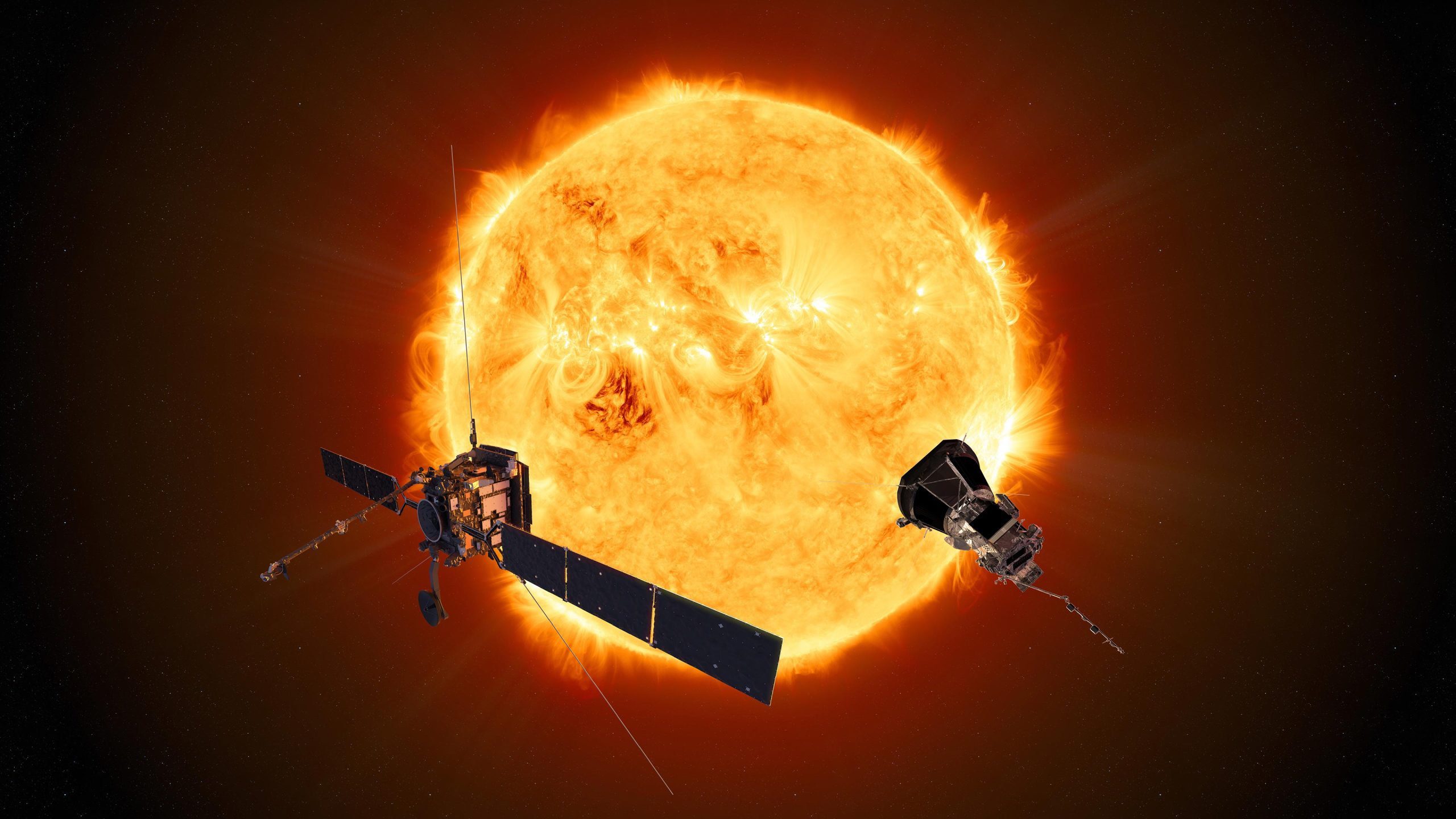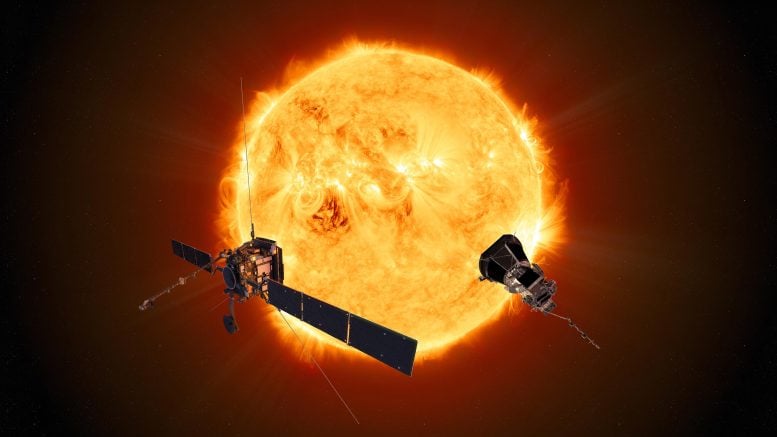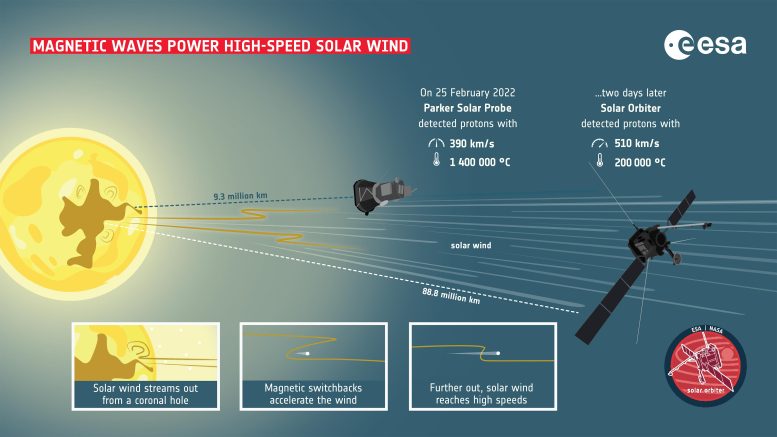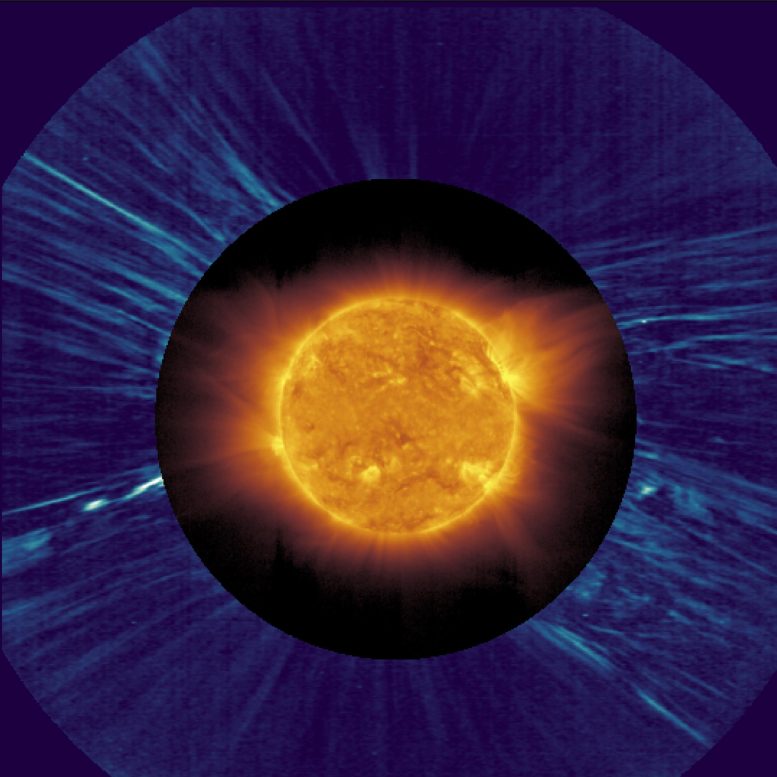

Data from ESA’s Solar Orbiter and NASA’s Parker Solar Probe have revealed that large fluctuations in the Sun’s magnetic field, specifically Alfvén waves, are key to powering and accelerating the solar wind.
This discovery sheds light on the dynamics of solar phenomena and suggests potential similarities in other stars’ winds.
Unveiling Solar Wind Mysteries
The European Space Agency’s (ESA) Solar Orbiter spacecraft has provided crucial data to answer the decades-long question of where the energy comes from to heat and accelerate the solar wind. Working in tandem with NASA’s Parker Solar Probe, Solar Orbiter reveals that the energy needed to help power this outflow is coming from large fluctuations in the Sun’s magnetic field.
The solar wind is a constant stream of charged particles that escapes from the solar atmosphere (called the corona) to flow out past Earth. It’s the collision of the solar wind with our planet’s atmosphere that triggers the colorful aurora in our skies.
The Role of Alfvén Waves
‘Fast’ solar wind moves with speeds above 500 km/s, equivalent to a whopping 1.8 million km/h. Curiously, this wind exits the Sun’s corona with lower speeds, so something speeds it up as it moves farther away. The million-degree wind naturally cools down as it expands into a larger volume and becomes less dense, much like the air on Earth as you climb a mountain. And yet, it cools more slowly than expected from this effect alone.
So, what provides the necessary energy to accelerate and heat the fastest parts of the solar wind? Data from ESA’s Solar Orbiter and NASA’s Parker Solar Probe have provided conclusive evidence that the answer is large-scale oscillations in the Sun’s magnetic field, known as Alfvén waves.
“Before this work Alfvén waves had been suggested as a potential energy source, but we didn’t have definitive proof,” says joint first author of the work Yeimy Rivera from the Center for Astrophysics, Harvard & Smithsonian, Massachusetts.

Discovering the Energy Dynamics
In an ordinary gas, such as Earth’s atmosphere, the only kind of waves that can be transmitted are sound waves. However, when a gas is heated to extraordinary temperatures, such as in the Sun’s atmosphere, it enters an electrified state known as a plasma and responds to magnetic fields. This allows waves, called Alfvén waves, to form in the magnetic field. These waves store energy and can efficiently carry it through a plasma.
A normal gas expresses its stored energy in the form of density, temperature, and velocity. With a plasma, however, the magnetic field also stores energy. Both Solar Orbiter and Parker Solar Probe contain the necessary instruments to measure the properties of the plasma, including its magnetic field.
Scientific Collaboration and Findings
Although the two spacecraft are operating at different distances from the Sun, and in very different orbits, in February 2022, the spacecraft happened to align along the same stream of solar wind.
Parker, operating at 13.3 solar radii (around 9 million km) from the Sun at the very outer edges of the Sun’s corona, crossed the stream first. Solar Orbiter, operating at 128 solar radii (89 million km), then crossed the stream a day or two later. “This work was only possible because of the very special alignment of the two spacecraft that sampled the same solar wind stream at different stages of its journey from the Sun,” says Yeimy.
Taking full advantage of this rare alignment, the team compared the measurements of the same plasma stream at two different locations. They first transformed the measurements into four key energy quantities, which included a measurement of the stored energy in the magnetic field, called the wave energy flux.
Because energy can neither be created nor destroyed, only converted from one form to another, the team compared the readings from Parker to those from Solar Orbiter. They did this comparison both with and without the magnetic energy term.

Understanding Solar Wind Acceleration
“We found that if we didn’t include the wave energy flux at Parker, we don’t quite match how much energy we have at Solar Orbiter,” says joint first author Samuel Badman, Center for Astrophysics, Harvard & Smithsonian, Massachusetts.
Close to the Sun, where Parker measured the stream, around 10% of the total energy was found in the magnetic field. At Solar Orbiter, this number had dropped to just 1% but the plasma had accelerated and had cooled more slowly than expected.
Comparing the numbers, the team concluded that the lost magnetic energy was powering the acceleration and slowing down the cooling of the plasma by providing some heating of its own.
The data also show how important magnetic configurations known as switchbacks are to the acceleration of the wind. The switchbacks are large deflections in the Sun’s magnetic field lines and are examples of Alfvén waves. They have been seen since the first solar probes of the 1970s but their detection rate has dramatically increased since Parker Solar Probe became the first spacecraft to fly through the Sun’s corona in 2021 and detected that switchbacks join together in patches.
Broader Implications and Future Research
This new work confirms that these patches of switchbacks contain enough energy to be responsible for the missing portion of the acceleration and heating of the fast solar wind.
“This new work expertly brings together some large pieces of the solar puzzle. More and more, the combination of data collected by Solar Orbiter, Parker Solar Probe and other missions is showing us that different solar phenomena actually work together to build this extraordinary magnetic environment,” says Daniel Müller, ESA Project Scientist for Solar Orbiter.
And it’s not just telling us about our Solar System. “Our Sun is the only star in the Universe where we can directly measure its wind. So what we learned about our Sun potentially applies at least to other Sun-type stars, and perhaps other types of stars that have winds,” says Samuel.
The team is currently working on expanding their analysis to apply to slower forms of the solar wind, to see whether the Sun’s magnetic field energy plays a role in their acceleration and heating too.
Reference: “In situ observations of large-amplitude Alfvén waves heating and accelerating the solar wind” by Yeimy J. Rivera, Samuel T. Badman, Michael L. Stevens, Jaye L. Verniero, Julia E. Stawarz, Chen Shi, Jim M. Raines, Kristoff W. Paulson, Christopher J. Owen, Tatiana Niembro, Philippe Louarn, Stefano A. Livi, Susan T. Lepri, Justin C. Kasper, Timothy S. Horbury, Jasper S. Halekas, Ryan M. Dewey, Rossana De Marco and Stuart D. Bale, 29 August 2024, Science.
DOI: 10.1126/science.adk6953
Solar Orbiter, a mission spearheaded by the European Space Agency (ESA) in collaboration with NASA, is a deep-space probe designed to study the Sun up close. Launched in February 2020, its primary objectives include examining the solar atmosphere, capturing high-resolution images of the Sun’s poles, and investigating the solar wind and the Sun’s magnetic fields. By orbiting closer to the Sun than Mercury, Solar Orbiter endures extreme solar radiation to gather critical data, helping scientists understand the mechanisms behind solar activity and its effects on the wider solar system.

